Know the Etymology: 380
Place Name of the Day: Tuesday, 13 January 2015
Karaiyaakkan-theevu
கரையாக்கன் தீவு
Karaiyākkaṉ-tīvuKaraiyaakkan+theevu
The water-surrounded place found with Karaiyaakan trees
The water-surrounded place of the spirit called Karaiyaakkan
| Karaiyaakkan 1 |
Also Karaiyaakku: Ixora coccinea (Eezham Tamil, Batticaloa dialect); a shrub name found used in Batticaloa. The shrub bearing crimson red composite flowers, identified with Vedchi (Ixora coccinea) in Changkam Tamil and Karuveeram in other Tamil usages, is specifically chosen to make Kompu (made from a forked branch of the tree) used in a folk martial play called Kompu-vi'laiyaaddu in Batticaloa (Eezham Tamil, V.C. Kanthaiya, 1964, p.181); Ka'rai: stain, darkness, rust (Tamil, DED 1395); Acacia catechu sundra, a kind of ebony (Tamil, Winslow, MTL); Ka'luwara: ebony, dark (Sinhala); Rath-mal: literally meaning the red or blood flower, Ixora coccinea (Sinhala); Vedchi: Ixora coccinea, probably from the root Veddu: to cut as with sword or axe, to cause bleeding (Tamil, DED 5478); Koaraan: Torch Tree, Ixora parviflora (Tamil, DED 2229); Ko'roy: A burning torch (Konda, DED 2229)
|
| Karaiyaakkan 2 |
A devil, spirit or folk deity that is evoked in the witchcraft of Batticaloa (V.C. Kanthaiya, 1964, p. 345); probably from Karu+yakkan, Ka'rai+yakkan: the dark Yaksha or stained/ blood-stained Yaksha; also note the folk deity name Valliyakkan (Val+iyakkan, meaning the mighty Yaksha) in the folk religion of the Pa'raiyar community of Jaffna; Ixora coccinea: the Latin botanical term literally means the crimson flower of a deity of Malabar; Ixora: the term has come from a deity of Malabar, i.e., Tamil Nadu/ Kerala (David Gledhill, The Names of Plants, Cambridge, 2008); probably from Isvara meaning Siva or Asura meaning a demon; Coccinea: crimson, scarlet (David Gledhill, The Names of Plants, Cambridge, 2008) |
| Theevu |
island, islet; in the context of this place an open land projecting into the Batticaloa lagoon and surrounded by water seasonally. See following boxes on etymology. Also see column on Koonith-theevu
|
| Theevu 1 |
island (Tamil, Changkam Diction and modern; Pu'ranaanoo'ru 397: 21-22; Theev: island (Malayalam); Theeyan, Theevan: the caste of palm cultivators, toddy-drawers, sugar-makers, said to be islanders from Ceylon (Malayalam, DED 3277 cites Sanskrit Dveepa); Dveepa: land, island (Sanskrit, Rig Vedic, CDIAL 6691); island, peninsula, sandbank (Sanskrit, Monier Williams); Deepa, Deepaka: island (Pali, CDIAL 6691); Deeva: island (Prakrit, CDIAL 6691); Dveepa/ Dveepaya/ Doopata/ Divaina: island (Sinhala); Doova: island, any small spot of ground or bank surrounded by water (Sinhala); Dhoo/ Dhuvu/ Dhuvaa/ Doo/Dheefu /Theemu: island (Dhivehi / Maldivian, An Etymological Dictionary of Maldivian Island Names); Jeeva: island, as in Pa’nagn-jeeva equivalent to Pazhan-theevu (old Maldivian copper plates)
|
| Theevu 2 |
The term may also have affinities to the following words of Dravidian etymology, listed by Dravidian Etymological Dictionary, entry No 3229: Thippai: mound, elevated ground (Tamil); Tip: rubbish heap (Kodagu); Tippe: heap, hillock, dunghill (Kannada); Dibba, Dibbu: eminence, hillock (Kannada); Tevaru, Tevari: rising ground, hillock (Kannada); Tippe: heap, pile, hill (Tulu); Tuppe: stack, heap of corn, rice (Tulu); Tippa: hill, hillock, rock, mountain, heap, mound, small island (Telugu); Dibba: hillock, mound, heap (Telugu); Dippa: heap (Parji); Dibba: mound (Parji); Dibbe: hillock (Gadba); Dippa: highland for cultivation, forest, field (Gondi); Deebe: heap (Gondi); Depa: rising ground, high land, lower slopes of a hill, shore, earth platform, veranda, dais (Kui); Debbe: hill (Kuvi); Baali dibba: sandhill (Kuvi); Dippaa: mound, hillock (Kurux); Tube: a heap of filth or sweepings (Malto); also the following entries under DED 3239: Dimmi: elevated spot (Kannada, DED 3239): Neer-demma: island (Parji); also, DED 3221: Thidar, Thidal: rising ground, bank, island (Tamil)
|
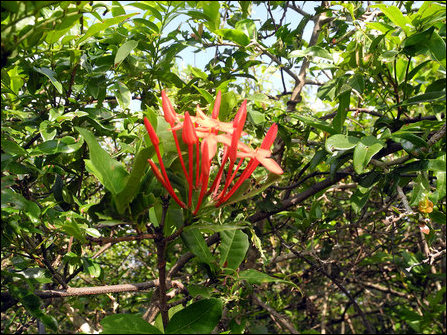
Karaiyaakkan/ Vedchi/ Rathmal/ Ixora coccinea photographed at Va'n'na Ma'niyar Thu'rai on the banks of Maduru Oya delta in Koara'laippattu division of Batticaloa district [Photo: TamilNet]

Images of Kompu used in the ritual/martial game called ‘Kompu Vi'laiyaaddu’ in Batticaloa. They are prepared from forking branches of Karaiyaakku tree. Top: Vadacherik-kompu, Middle: Thenchearik-kompu, Bottom: Kompu prepared for locking. [Image courtesy: V.C. Kanthaiya, 1964]
The word Karaiyaakkan or Karaiyaakku is a shrub name in Batticaloa dialect of Eezham Tamil. The addition of 'An' suffix is a common feature in Eezham Tamil.
Pundit V.C. Kanthaiya in his 1964 book “Maddakka'lapputh Thamizhakam” (p. 181) notes that the Karaiyaakku tree is the one that must particularly be used in making Kompu, which is a play tool made from forked branches of the tree and used in a game called Kompu Vi'laiyaaddu (the Kompu Play).
This is a folk ritual as well as a martial play in which a village divided for this purpose into two patrilineal groups, calling themselves as Chearis (hamlets), one on the side of the deity Ka'n'naki and the other on the side of her husband Koavalan, go for tug-of-war, locking their respective Kompus tied with ropes. The game will continue until one of the Kompus snaps. Kompu literally means branch of a tree as well as horn of an animal.
For the Karaiyaakku shrub or tree, the equivalent names Kanthaiya gives are Vedchi and Karuveeram (p.181).
Madras Tamil Lexicon entry for Vedchi gives the botanical term as Ixora cocccinea. This is a shrub, the flowers of which were worn in the military situation of capturing the cattle herds of enemies, during Changkam times (Tholkaappiyam, Poru'l: 59-61).
The attributes of the game Kompu Vi'laiyaaddu or Kompu Mu'riththal in Batticaloa show the synthesis of pastoral culture with the cult of Ka'n'naki.
The shrub name Karaiyaakku seems to be provincial to Batticaloa, as it is not found in standard dictionaries or lexicons. Winslow notes the word Ka'rai as the name of Acacia catechu sundra, which is a kind of ebony.
However, the shrub identified as Karaiyaakkan and photographed in Batticaloa confirms Kanthaiya's identification equating it to Vedchi/ Karuveeram (see photos and especially note the flowers of the type of Ixora coccinea).
The Karaiyaakkan/ Vedchi related folk-play and cult in Batticaloa, depicting a battle for capture, shows the survival of an ancient Tamil sociocultural theme and symbol in the memory of society and folk culture of Batticaloa.
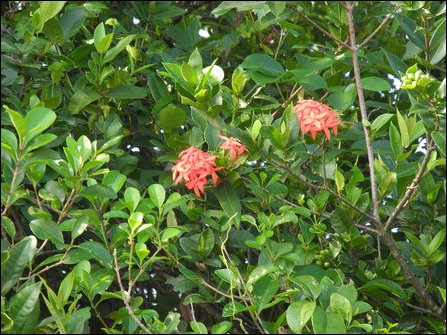
Foliage, flower and fruits: Karaiyaakkan/ Vedchi/ Rathmal/ Ixora coccinea photographed at Va'n'na Ma'niyar Thu'rai on the banks of Maduru Oya delta in Koara'laippattu division of Batticaloa district [photo: TamilNet]
“Kadattil kaliththa mudach chinai vedchi” (Ku'runthokai, 309: 5)
“கடற்றில் கலித்த முடச் சினை வெட்சி” (குறுந்தொகை, 309: 5)
The Vedchi of bent branches that was found abundantly grown in the arid tract/ jungle/ hillside/ difficult track
Vedchi meaning the literary theme of capturing the cattle herds of enemies: 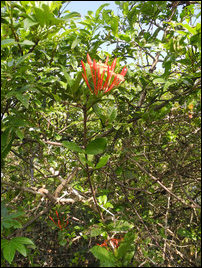
Flower buds:Karaiyaakkan/ Vedchi/ Rathmal/ Ixora coccinea photographed at Va'n'na Ma'niyar Thu'rai on the banks of Maduru Oya delta in Koara'laippattu division of Batticaloa district [Photo: TamilNet]
“Vedchi thaanea…veanthu vidu munaignar veattup pulak ka'lavin aa thanthu oampal” (Tholkaappiyam, Poru'l, Pu'raththi'nai, 59-60)
“வெட்சி தானே…வேந்து விடு முனைஞர் வேற்றுப் புலக் களவின் ஆ தந்து ஓம்பல்” (தொல்காப்பியம், பொருள், புறத்திணை, 59-60)
Vedchi (as a literary theme) means a king sending his frontline villagers into the territory of his enemy king for the purpose of plunder before invasion, and they capturing, bringing and maintaining the cattle of that territory in their territory.
The 14 subthemes of Vedchi are: the enthusiastic bustle of the plunderers when the mission is announced; the plunderers seeking good omens to start; secretly going for the plunder by keeping the spies of the enemies in dark; the enemy king through his spies knowing the conditions of the plunderers; surrounding the enemy village and staying there; the resulting destruction and killing in the enemy village; the battle for the capture of cattle; the battle victory; bringing the cattle without harming them; the relatives of the plunderers waiting for their return; penning the cattle and fulfilling the mission; dividing the plunder among the captors; drinking, eating and celebrating the victory and out of what has come as one's share giving cattle as charity to the needy. (Tholkaappiyam, Poru'l, Pu'raththi'nai, 61)
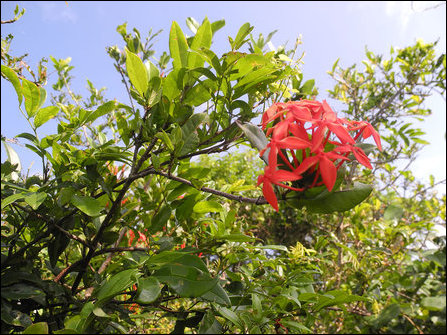
Flowers, close-up: Karaiyaakkan/ Vedchi/ Rathmal/ Ixora coccinea photographed at Va'n'na Ma'niyar Thu'rai on the banks of Maduru Oya delta in Koara'laippattu division of Batticaloa district [photo: TamilNet]
A devil, spirit or a folk deity is also called Karaiyaakkan in Batticaloa dialect of Eezham Tamil. This is an evil spirit that is evoked in the witchcraft of Batticaloa (V.C. Kanthaiya, p. 345).
The word probably has come from Ka'rai-yakkan, meaning the stained/ blood-stained/ dark Yakska or Karu-yakkan, meaning the dark Yaksha.
The term is also comparable to the name of a folk deity, Valliyakkan (Val+iyakkan, meaning the mighty Yakska), worshipped by the Pa'raiyar community in Jaffna.
Karaiyaakkan meaning the shrub Ixora coccinea of crimson red flowers as well as a particular spirit or demon are probably interrelated. According to plant classification glossaries, the botanical term Ixora itself has come from the name of a deity of Malabar (Tamil Nadu/ Kerala) and the suffix coccinea means crimson red or scarlet colour (David Gledhill, The Names of Plants, Cambridge University Press, 2008, p. 113, 219).
There is a probability that Ixora has come from Isvara meaning Siva or Asura meaning a demon. As a wild flower, Vedchi/ Karaveeram is favoured in the worship of Siva. Also note the synonym Karuveeram for Karaiyaakkan, given by Kanthaiya. Karuveeram (Karu+veeram) means 'dark might'.
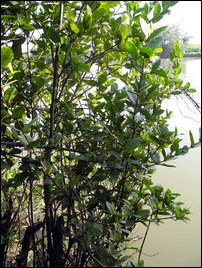
Karaiyaakkan/ Vedchi/ Rathmal/ Ixora coccinea found grown on the banks of the Maduru Oya River delta at Va'n'na Ma'niyar Thu'rai in Koara'laippattu division of Batticaloa district [photo: TamilNet]
Batticaloa Tamil coining the term Karaiyaakkan to mean the shrub by its name as well as an evil spirit or demon, and the association of the shrub in a folk practice coming from the memories of ancient Tamil culture, probably show the synthesis of Vedda and Tamil cultural elements.
Another etymological possibility is the prefix being related to Koaraan, the Tamil/ Dravidian term for Ixora parviflora (DED 2229), which in turn is related in meaning to a burning torch or firebrand. Ko'roy in Konda means a burning torch (DED 2229). There is a probability that these words are Veddoid/ Austro Asiatic. A Comparative Dictionary of Indo-Aryan Languages has no entry for Ixora.
The Sinhala name for Ixora coccinea is Rath-mal, literally meaning the red or blood flower. In Sinhala traditions the flower is particularly used in the worship of Kumaara/ Skanda/Murukan/ Lord Kataragama, and in the worship of the nine planets. It is also used in the propitiation of demons and in making garlands for cattle.
Rath-mal as a component is found in many Sinhala place names of the Dry Zone
* * *Theevu normally means an island or islet. But, a coastal high ground in a seasonally waterlogged area is also often called a Theevu in the place names of the island. See boxes above and earlier place names for etymology.
* * *Karaiyaakkan-theevu is a place in Ma'nmunai West division of Batticaloa district.
* * *Some related place names: Ratmalaana: The place of Rathmal shrubs; Ratmalana division, Colombo district
Rathmal-de'niya: The ground of Rathmal shrubs placed between high grounds; Kesbewa division, Colombo district
Rathmal-vita: The mound of Rathmal shrubs; Gampaha division, Gampaha district
Rathambalea: The place of Ratmal shrubs; Attanagala division, Gampaha district. Rathambala and Rathmal are synonyms (Sinhala)
Rathmal-goda: The bank of Rathmal shrubs; Ingiriya division, Kalutara district; Polgahawela division, Kurunegala district
Rathmalea: The place of Rathmal shrubs or the red hill; Agalawatta division, Kalutara district
Rathmal-kaduwa: The jungle of Rathmal shrubs; Udapalatha division, Kandy district; Dambulla division, Matale district
Rathmal-gaha-æ'la: The river or canal of Rathmal shrubs; Dambulla division, Matale district
Rathmal-wala: The jungle of Rathmal shrubs; Angunakolapelessa division, Hambantota district
Rathmal-yaaya: The expanse of Rathmal shrubs; Puththa'lam division, Puththa'lam district
Rathmal-agaara: The house or dale of Rathmal shrubs; Madampe division, Puththa'lam district
Rathmal-gaha-wæwa: The tank identified with Rathmal shrubs; Kahatagasdigiliya division, Anuradhapura district
Rathmallæwa: The place of Rathmal shrubs; or the tank identified with Rathmal shrubs; Kekirawa division, Anuradhapura district
Rathmal-thænna: The place of Rathmal shrubs; or the high ground of Rathmal shrubs; Dimbulagala division, Polonnaruwa district
Revised: Tuesday, 13 January 2015, 20:22
First published: Monday, 24 November 2014, 17:45
Previous columns:














